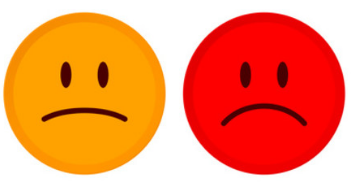Negative Work Behaviors (NWBs)
Negative work behaviors are voluntary behaviors that violate significant organizational norms and threaten the well-being of the organization or its members. Some examples are;
- theft
- fraud
- sabotage
- sharing an organization confidential information
- absenteeism
- poor attendance
- withholding effort
- workplace aggression
- sexual harassment
- workplace bullying
The target of the negative behaviors can be the organization, other individuals or even the self.
Negative work behaviors have been found to have significant relationships with abusive supervision, unethical and negative leadership, stress, low self-esteem and negative emotions in the workplace. Negative emotions are one of the strongest links with negative work behaviors.
As might be expected there is a significant negative effect on organizational effectiveness.
Much of the early research investigated negative work behaviors in terms of personality, finding links with some high level personality factors. This suggests that selection procedures can be used to reduce the likelihood of negative work behaviors. However personality measures are not reliable indicators of future behavior. Personality is by definition an enduring preference for certain patterns of behavior, so once a person is on board, very hard to change.
Recent research has focused on factors that are more amenable to change.
- Dysfunctional Leadership
- Negative Feedback
- Performance Management Systems
1. Dysfunctional Leadership (DL)
Abusive leadership is defined as the perception by staff that managers engage in sustained hostile verbal and non-verbal behavior (excluding physical contact). Dysfunctional leadership includes:
Example DL behaviors include
- close supervision
- frequent reprimands
- unfair and public criticism
- coldness, suspicion
- with-holding information
- inflexibility
- arbitrary decisions without consultation,
- blaming staff for failures
- taking personal credit for successful work of others
Dysfunctional leadership can have profound personal psychological effects on staff. These include stress, the undermining of self esteem and self efficacy which adversely impact job performance. DL is associated with a loss of commitment to the organization, negative work behaviors, and intention to leave.
The prevalence of perceived abusive leadership behavior has been estimated to affect 13% or more of the workforce based on survey data. Other aspects of dysfunctional leadership are likely to affect many more.
DL appears more prevalent in centralized hierarchical organizations, less prevalent in flatter more decentralized organizational structures. However staff in hierarchical organizations are less sensitive to it. There is also less sensitivity when the cause of the negative leadership behavior is perceived to be individual or unit performance rather than personality based.
2. Negative Feedback
What it is
 Negative feedback is feedback that indicates that employee performance does not meet organizational expectations. Drawing attention to performance gaps with the aim of closing them is a key part of performance management.
Negative feedback is feedback that indicates that employee performance does not meet organizational expectations. Drawing attention to performance gaps with the aim of closing them is a key part of performance management.
Many managers avoid giving negative feedback, seeing this as one of the most unpleasant aspects of a management role. This means that performance gaps are often not addressed. Sometimes the feedback is made so vague or watered down that it is useless. Sometimes poor performance is allowed to build to a point where frustration causes the feedback to be given in a dysfunctional manner. When managers do not address poor performance, good performers may become demoralized and/or exit the organization
The scarce research on comments in performance appraisals show they tend to be ineffective because they are too general and too short – where they exist. One study found 44% of staff reviews had less than 5 sentences for a whole year’s work on average. There was very little negative feedback, only 14% contained any suggestion for improvement, with only 2% of those primarily negative feedback.
Reactions to Negative Feedback
Negative feedback always prompts an uncomfortable emotional response – anger, frustration, discouragement, unhappiness. On the other hand positive feedback makes people feel good.
The discomfort distracts people from the message in the feedback and puts them in defensive mode. They may perceive the feedback as meaning they are incompetent. In many cases negative feedback becomes demotivating, prompting denial rather than an effort to close the gaps.
Receptivity to feedback does vary with personality. People who are low on some of the Big Five personality factors – agreeableness, emotional stability, conscientiousness and openness to experience are more likely to respond poorly to negative feedback.
Overcoming the negatives
Research shows that the commonly given prescriptions of making feedback timely, specific and task focused are not enough to prevent bad feelings.
What is needed is a focus by managers on communicating the positives as well as the negatives. It is vital to protect and nurture the staff member’s feelings of self-efficacy which are closely linked to job performance.
Recent research points to the following as being effective;
- Limiting distractions when providing feedback and focusing solely on the staff member.
- Showing empathy – conveying interest, acceptance and reassurance with warmth and concern.
- Asking questions that prompt the staff member to think about the ideal situation and solution, the best possible outcomes, new ideas for getting there
- Asking staff to visualize the positive – what success would look like, how will people receive this success.
- Asking staff to think about personal development goals – prompting a focus on developing competency a positive , rather than avoiding poor performance a negative.
An experimental study examined the effect of the sequence of positive and corrective statements when giving feedback. Corrective statements were given at the beginning middle or end of a sequence containing 2 positive statements. The statements were task specific and contained both quantitative and qualitative feedback. While the sequence made no difference to subsequent task performance most participants preferred to hear the corrective (negative) statement first followed by positive statements.
3. Performance Management Systems (PMS)

Effect on NWBs
A performance management system has the central purpose of influencing employee work behaviors in pursuit of organizational outcomes.
An enabling PMS is one which is flexible and which allows employees to determine how best to achieve a set of goals. A coercive system is one where employees are given goals – told how to achieve them and have no flexibility to change this.
Generally employees with an enabling system feel more empowered and committed and have more job satisfaction. Employees want freedom and meaning in their work, thus the use of an enabling PMS decreases NWB.
This is the case at the individual level, even where an individual may put their own interests before that of the team or organization. This because they have the freedom to choose a range of work behaviors that benefit themselves but that are not negative work behaviors that will adversely impact the opinions others have of them.
However in the case where the entire team has intense self-interest, and is highly cohesive, they are likely to engage in group think and NWBs that promote their self interest. This is because there is no constraint of the opinions of others.
Alleviating adverse impact
- The PMS must show for each individual how their goals contribute to their team and the organization as a whole.
- It must be clear how each team and department in the organization contributes and supports the others.
- Teams need to be trained in group dynamics so group think and group bias can be avoided.
- The PMS should include clear standards for ethical behavior and citizenship behaviors as core competencies.

References
AN EMOTIONAL PROCESS THEORY OF HOW SUBORDINATES APPRAISE, EXPERIENCE, AND RESPOND TO ABUSIVE SUPERVISION OVER TIME (2017) Oh, J. , Farh. C. Academy of Management Review Vol. 42, No. 2, 207–232
ABUSIVE SUPERVISION AND EMPLOYEES’ JOB PERFORMANCE: A MULTIPLE MEDIATION MODEL (2017) Chen, Z., Wang H. SOCIAL BEHAVIOR AND PERSONALITY, 2017, 45(5), 845–858
I JUST CAN’T CONTROL MYSELF: A SELF-REGULATION PERSPECTIVE ON THE ABUSE OF DEVIANT EMPLOYEES. (2017) Mawritz M.B. et al. Academy of Management Journal Vol. 60, No. 4, 1482–1503.
Examining the Role of Narrative Performance Appraisal Comments on Performance. (2013) David, E.M. Human Performance, 26:430–450
Negative Feedback & employee job performance moderating role of the big five. (2017) Yun G.et al. SOCIAL BEHAVIOR AND PERSONALITY, 45(10), 1735–1744
The Influence of Feedback Statement Sequence and Goals on Task Performance (2017) Slowiak, Lakowske, A.M. Behavior Analysis: Research and Practice Vol. 17, No. 4, 357–380
The intersection of Bad Apples, Bad Barrels and the enabling use of Performance Measurement Systems. (2017) Burney, L.L. , Radtke,R.R. Journal of Informations Systems Vol 31,(2) pp25-48.



